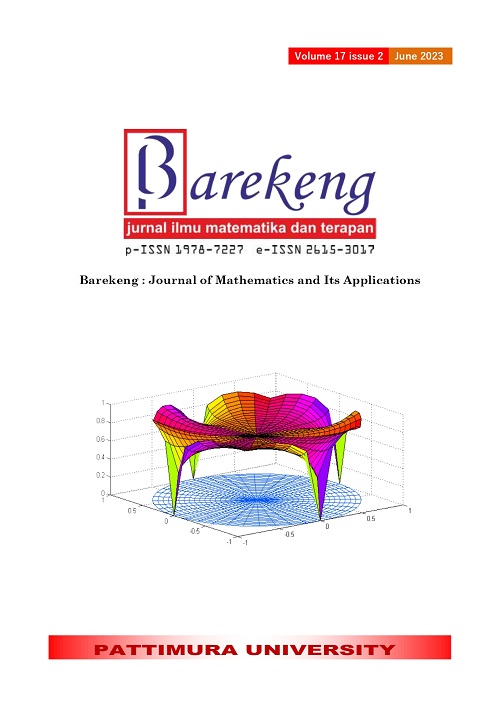DYNAMICAL SYSTEM FOR EBOLA OUTBREAK WITHIN QUARANTINE AND VACCINATION TREATMENTS
Abstract
Ebola Virus Disease (EVD) is an infectious disease with a high mortality rate which is caused by the virus from the family of Filoviridae, genus of Ebolavirus. Therefore, this research works on the developing model of Ebola disease spread with SLSHVEQIHR type. The purpose of this study is to analyze the spread of Ebola disease with the treatments, which are quarantine and vaccination. Then determine the equilibrium point and basic reproduction number (R0). There are two equilibrium points, the disease free equilibrium point and the endemic equilibrium point. The analysis results in the model show that if R0<1 than the disease free equilibrium point is locally asymptotically stable. If R0>1 than the endemic equilibrium point is locally assymptotically stable. Numerical simulations are performed to show the population dynamics when R0<1and R0>1.
Downloads
References
P. Shears and C. Garavan, “The 2018/19 Ebola epidemic the Democratic Republic of the Congo (DRC): epidemiology, outbreak control, and conflict,” Infect. Prev. Pract., vol. 2, no. 1, p. 100038, 2020, doi: 10.1016/j.infpip.2020.100038.
H. Yueh-Min et al., “A Jigsaw-based Cooperative Learning Approach to Improve Learning Outcomes for Mobile Situated Learning,” J. Educ. Technol. Soc., vol. 17, no. 1, pp. 128–140, 2014, doi: 10.2307/jeductechsoci.17.1.128.
C. K. Kebenei and P. Okoth, “Ebola Virus Disease, Diagnostics and Therapeutics: Where is the Consensus in Over Three Decades of Clinical Research?,” Sci. African, vol. 13, p. e00862, 2021, doi: 10.1016/j.sciaf.2021.e00862.
BBC NEWS Africa, “Ebola: Mapping the outbreak,” 2016. https://www.bbc.com/news/world-africa-28755033 (accessed Sep. 12, 2021).
J. Sun et al., “Ebola virus outbreak returns to the Democratic Republic of Congo: An urgent rising concern,” Ann. Med. Surg., vol. 79, no. May, pp. 3–7, 2022, doi: 10.1016/j.amsu.2022.103958.
Centers for Disease Control, “Ebola (Ebola Virus Disease),” 2021. https://www.cdc.gov/vhf/ebola/transmission/index.html (accessed Sep. 12, 2021).
World Health Organization, “Ebola virus disease,” 2021. https://www.who.int/en/news-room/fact-sheets/detail/ebola-virus-disease (accessed Sep. 12, 2021).
P. Diaz, P. Constantine, K. Kalmbach, E. Jones, and S. Pankavich, “A modified SEIR model for the spread of Ebola in Western Africa and metrics for resource allocation,” Appl. Math. Comput., vol. 324, pp. 141–155, 2018, doi: 10.1016/j.amc.2017.11.039.
V. Piccirillo, “Nonlinear control of infection spread based on a deterministic SEIR model,” Chaos, Solitons and Fractals, vol. 149, p. 111051, 2021, doi: 10.1016/j.chaos.2021.111051.
A. Khan, M. Naveed, M. Dur-e-Ahmad, and M. Imran, “Estimating the basic reproductive ratio for the Ebola outbreak in Liberia and Sierra Leone,” Infect. Dis. Poverty, vol. 4, no. 1, p. 13, 2015, doi: 10.1186/s40249-015-0043-3.
P. Wintachai and K. Prathom, “Stability analysis of SEIR model related to efficiency of vaccines for COVID-19 situation,” Heliyon, vol. 7, no. 4, p. e06812, 2021, doi: 10.1016/j.heliyon.2021.e06812.
M. D. Ahmad, M. Usman, A. Khan, and M. Imran, “Optimal control analysis of Ebola disease with control strategies of quarantine and vaccination,” Infect. Dis. Poverty, vol. 5, no. 1, p. 72, 2016, doi: 10.1186/s40249-016-0161-6.
P. Van Den Driessche and J. Watmough, “Reproduction numbers and sub-threshold endemic equilibria for compartmental models of disease transmission,” Math. Biosci., vol. 180, no. 1–2, pp. 29–48, 2002, doi: 10.1016/S0025-5564(02)00108-6.
A. Alam and S. Sugiarto, “Analisis Sensitivitas Model Matematika Penyebaran Penyakit Antraks pada Ternak dengan Vaksinasi, Karantina dan Pengobatan,” J. Ilm. Mat. Dan Terap., vol. 19, no. 2, pp. 180–191, 2022, doi: doi: https://doi.org/10.22487/2540766X.2022.v19.i2.16017.
L. Edelstein-Keshet, Mathematical Models in Biology. New York: Random House, 2005.
S. F. Al-Azzawi, “Stability and bifurcation of pan chaotic system by using Routh-Hurwitz and Gardan methods,” Appl. Math. Comput., vol. 219, no. 3, pp. 1144–1152, 2012, doi: 10.1016/j.amc.2012.07.022.
C. Castillo-chavez, “Dynamical models of tuberculosis and applications,” CBMS-NSF Reg. Conf. Ser. Appl. Math., vol. 1, no. 84, pp. 191–217, 2013.
Copyright (c) 2023 Sugian Nurwijaya, Ratnah Kurniati MA, Sigit Sugiarto

This work is licensed under a Creative Commons Attribution-ShareAlike 4.0 International License.
Authors who publish with this Journal agree to the following terms:
- Author retain copyright and grant the journal right of first publication with the work simultaneously licensed under a creative commons attribution license that allow others to share the work within an acknowledgement of the work’s authorship and initial publication of this journal.
- Authors are able to enter into separate, additional contractual arrangement for the non-exclusive distribution of the journal’s published version of the work (e.g. acknowledgement of its initial publication in this journal).
- Authors are permitted and encouraged to post their work online (e.g. in institutional repositories or on their websites) prior to and during the submission process, as it can lead to productive exchanges, as well as earlier and greater citation of published works.






1.gif)



